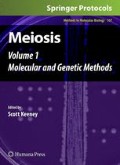Abstract
Caenorhabditis elegans is an important experimental organism for the study of recombination during meiosis. A variety of techniques have been developed for the measurement of meiotic recombination in C. elegans, ranging from traditional genetic measures to direct cytological determination of chiasma frequency. Here, we provide methods for some of the varied approaches used for the study of meiotic recombination in these tiny but powerful worms.
Access this chapter
Tax calculation will be finalised at checkout
Purchases are for personal use only
References
Keeney, S., Giroux, C. N., and Kleckner, N. (1997) Meiosis-specific DNA double-strand breaks are catalyzed by Spo11, a member of a widely conserved protein family. Cell 88, 375–84.
Dernburg, A. F., McDonald, K., Moulder, G., Barstead, R., Dresser, M., and Villeneuve, A. M. (1998) Meiotic recombination in C. elegans initiates by a conserved mechanism and is dispensable for homologous chromosome synapsis. Cell 94, 387–98.
Kim, J. S., and Rose, A. M. (1987) The effect of gamma radiation on recombination frequency in Caenorhabditis elegans. Genome 29, 457–62.
Petronczki, M., Siomos, M. F., and Nasmyth, K. (2003) Un menage a quatre: the molecular biology of chromosome segregation in meiosis. Cell 112, 423–40.
Villeneuve, A. M. (1994) A cis-acting locus that promotes crossing over between X chromosomes in Caenorhabditis elegans. Genetics 136, 887–902.
Stiernagle, T. (2006) WormBook, ed. the C. elegans Research Community, http://www.wormbook.org.
Davis, M. W., and Hammarlund, M. (2006) Single-nucleotide polymorphism mapping. Methods Mol. Biol. 351, 75–92.
Brenner, S. (1974) The genetics of Caenorhabditis elegans. Genetics 77, 71–94.
Wicks, S. R., Yeh, R. T., Gish, W. R., Waterston, R. H., and Plasterk, R. H. (2001) Rapid gene mapping in Caenorhabditis elegans using a high density polymorphism map. Nat. Genet. 28, 160–4.
Hammarlund, M., Davis, M. W., Nguyen, H., Dayton, D., and Jorgensen, E. M. (2005) Heterozygous insertions alter crossover distribution but allow crossover interference in Caenorhabditis elegans. Genetics 171, 1047–56.
Nabeshima, K., Villeneuve, A. M., and Hillers, K. J. (2004) Chromosome-wide regulation of meiotic crossover formation in Caenorhabditis elegans requires properly assembled chromosome axes. Genetics 168, 1275–92.
Alpi, A., Pasierbek, P., Gartner, A., and Loidl, J. (2003) Genetic and cytological characterization of the recombination protein RAD-51 in Caenorhabditis elegans. Chromosoma 112, 6–16.
Martin, J. S., Winkelmann, N., Petalcorin, M. I., McIlwraith, M. J., and Boulton, S. J. (2005) RAD-51-dependent and -independent roles of a Caenorhabditis elegans BRCA2-related protein during DNA double-strand break repair. Mol. Cell. Biol. 25, 3127–39.
Rinaldo, C., Bazzicalupo, P., Ederle, S., Hilliard, M., and La Volpe, A. (2002) Roles for Caenorhabditis elegans rad-51 in meiosis and in resistance to ionizing radiation during development. Genetics 160, 471–9.
Liu, H., Jang, J. K., Kato, N., and McKim, K. S. (2002) mei-P22 encodes a chromosome-associated protein required for the initiation of meiotic recombination in Drosophila melanogaster. Genetics 162, 245–58.
Thorne, L. W., and Byers, B. (1993) Stage-specific effects of X-irradiation on yeast meiosis. Genetics 134, 29–42.
Chin, G. M., and Villeneuve, A. M. (2001) C. elegans mre-11 is required for meiotic recombination and DNA repair but is dispensable for the meiotic G(2) DNA damage checkpoint. Genes Dev. 15, 522–34.
Colaiacovo, M. P., MacQueen, A. J., Martinez-Perez, E., McDonald, K., Adamo, A., La Volpe, A., and Villeneuve, A. M. (2003) Synaptonemal complex assembly in C. elegans is dispensable for loading strand-exchange proteins but critical for proper completion of recombination. Dev. Cell 5, 463–74.
Hayashi, M., Chin, G. M., and Villeneuve, A. M. (2007) C. elegans germ cells switch between distinct modes of double-strand break repair during meiotic prophase progression. PLoS Genet. 3, 2068–84.
McKim, K. S., Howell, A. M., and Rose, A. M. (1988) The effects of translocations on recombination frequency in Caenorhabditis elegans. Genetics 120, 987–1001.
Edgley, M. L., Baillie, D. L., Riddle, D. L., and Rose, A. M. (2006) Genetic balancers. WormBook, ed. the C. elegans Research Community, http://www.wormbook.org.
Kelly, K. O., Dernburg, A. F., Stanfield, G. M., and Villeneuve, A. M. (2000) Caenorhabditis elegans msh-5 is required for both normal and radiation- induced meiotic crossing over but not for completion of meiosis. Genetics 156, 617–30.
Zetka, M. C., and Rose, A. M. (1990) Sex-related differences in crossing over in Caenorhabditis elegans. Genetics 126, 355–63.
Fire, A., Xu, S., Montgomery, M. K., Kostas, S. A., Driver, S. E., and Mello, C. C. (1998) Potent and specific genetic interference by double-stranded RNA in Caenorhabditis elegans. Nature 391, 806–11.
Author information
Authors and Affiliations
Editor information
Editors and Affiliations
Rights and permissions
Copyright information
© 2009 Humana Press, a part of Springer Science+Business Media, LLC
About this protocol
Cite this protocol
Hillers, K.J., Villeneuve, A.M. (2009). Analysis of Meiotic Recombination in Caenorhabditis elegans . In: Keeney, S. (eds) Meiosis. Methods in Molecular Biology, vol 557. Humana Press. https://doi.org/10.1007/978-1-59745-527-5_7
Download citation
DOI: https://doi.org/10.1007/978-1-59745-527-5_7
Published:
Publisher Name: Humana Press
Print ISBN: 978-1-934115-66-4
Online ISBN: 978-1-59745-527-5
eBook Packages: Springer Protocols

